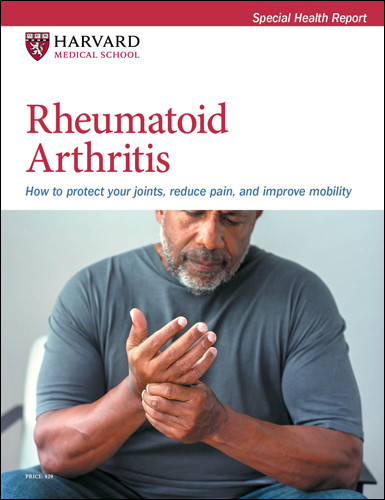Trouble treating rheumatoid arthritis
Many people diagnosed with rheumatoid arthritis later in life aren't getting the most effective medications for it.
- Reviewed by Anthony L. Komaroff, MD, Editor in Chief, Harvard Health Letter; Editorial Advisory Board Member, Harvard Health Publishing

The initial treatment for active rheumatoid arthritis (RA) is supposed to be aggressive. Doctors can pre-scribe powerful medications to slow the chronic immune system attack on the lining of the joints, and the drugs should be administered as soon as possible to help prevent crippling disability.
Unfortunately, most people diagnosed after age 65 (which includes up to a third of all people with rheumatoid arthritis) aren't getting optimal treatment, according to recent evidence. Here's why this might be happening to people with "late-onset" RA, and what you can do about it.
Recent evidence
In a study published Dec. 5, 2023, in ACR Open Rheumatology, scientists used Medicare data from 2008 to 2017 to identify people with a new diagnosis of late-onset RA. Among more than 33,000 people who fit the profile, just 29% received a medication that can modify the disease within the first year after diagnosis, even though such treatment is recommended by current clinical practice guidelines.
"This is in contrast with 70% to 80% of younger adults with rheumatoid arthritis who receive disease-modifying medications soon after diagnosis," says Dr. Devyani Misra, a geriatrician, rheumatologist, and researcher at Harvard-affiliated Beth Israel Deaconess Hospital.
Why disease-modifying drugs are important
The most effective rheumatoid arthritis medications not only relieve symptoms, but also slow the disease process. That helps reduce the amount of joint destruction and curb the loss of joint function.
In most cases, the first-line treatment is a nonbiologic disease-modifying antirheumatic drug (DMARD) such as methotrexate (Otrexup, Trexall), typically taken as a pill or self-injection.
If a nonbiologic DMARD doesn't provide significant improvement within a month or two, you might be offered a newer type of DMARD, such as one of the following.
Biologic DMARDs, such as etanercept (Enbrel), rituximab (Rituxan), or tocilizumab (Actemra), have a more targeted effect on immune system function than nonbiologic DMARDs. They are typically given as infusions or are self-injected.
Janus kinase inhibitors, such as tofacitinib (Xeljanz), like other DMARDs, reduce inflammation. They are taken as pills.
Until those medications begin to work (within weeks to months), doctors might recommend low doses of nonsteroidal anti-inflammatory drugs (NSAIDs), such as ibuprofen (Advil, Motrin), or corticosteroids, such as prednisone. But these medications do not protect the joints from damage, and long-term use can carry significant side effects.
What's the holdup?
Many factors keep people who develop late-onset RA from getting the most effective medications. Here are some examples.
Cost. Biologic DMARDs and Janus kinase inhibitors are expensive, with price tags upward of $20,000 or more per year. While they are often covered by insurance, copays and deductibles might translate to hundreds or thousands of dollars per year.
Side effects. All three classes of DMARD medications (like all drugs) can have side effects. For example, nonbiologic DMARDs can cause fatigue and liver problems; biologic DMARDs increase the risk for infections, especially tuberculosis; and Janus kinase inhibitor use can lead to shingles, allergic reactions, diarrhea, headache, runny or stuffy nose, or sore throat. Dr. Misra says some people decline the medications to avoid those risks.
Coexisting conditions. By the time late-onset RA develops, some people have other conditions that complicate treatment, such as heart or kidney problems. "Even aging itself can complicate rheumatoid arthritis treatment, in that liver, kidney, and gut function decline as we age, and the immune system becomes a little dysfunctional," Dr. Misra says.
Perceived frailty. "Some health care providers might be nervous about how medication side effects will affect someone they perceive as being frail, and then select the least aggressive treatment, such as a corticosteroid to ease symptoms," Dr. Misra says. "Yet I often prescribe DMARDs in older patients, and the drugs are effective and well tolerated."
Cognitive impairment. "Cognitive impairment interferes with the ability to follow instructions for medication use, lab monitoring, and clinic visit follow-ups. It's an ethical dilemma to determine how aggressively we want to treat these patients," Dr. Misra says.
Accessibility to health care. About 1.5 million people in the United States have rheumatoid arthritis, but there are only about 6,000 rheumatologists (doctors who are experts in treating the condition and who are most likely to prescribe DMARDs). So you might not have a specialist in your town who can navigate the challenges of late-onset RA. Even if you do, you might not have transportation, funds, or physical strength for in-person visits or infusions.
What you can do
If you aren't getting DMARD treatment for rheumatoid arthritis but feel you should be, talk to your doctor about workarounds to make treatment more feasible. Here are some examples.
If you can't give yourself injections. Infusions or an oral drug might be a better option.
If you can't get to a clinic. It might be possible to have a service provide blood work or infusions at home.
If you can't take methotrexate. A different medication might be a better fit when methotrexate isn't an option due to medication allergies or liver or kidney disease.
If you have cognitive impairment. "Perhaps you can have a family member or a visiting nurse give you your medications, or use an electronic pill-dispensing box," Dr. Misra suggests.
If the medications are too expensive. Ask your pharmacist about manufacturer coupons and patient assistance programs that can help reduce the costs of RA drugs.
If you're worried about side effects. "We often can find a drug that is the most benign, but still relieves discomfort," Dr. Misra says. "Or we can arrange the use of other therapies, such as physical or occupational therapy, topical creams, or heat and ice therapy. When we put them all together, they often provide pain relief. This is all about improving your quality of life, which will decline if you don't have treatment. And you're not too old to be treated."
Image: © Halfpoint Images/Getty Images
About the Author

Heidi Godman, Executive Editor, Harvard Health Letter
About the Reviewer

Anthony L. Komaroff, MD, Editor in Chief, Harvard Health Letter; Editorial Advisory Board Member, Harvard Health Publishing
Disclaimer:
As a service to our readers, Harvard Health Publishing provides access to our library of archived content. Please note the date of last review or update on all articles.
No content on this site, regardless of date, should ever be used as a substitute for direct medical advice from your doctor or other qualified clinician.
















